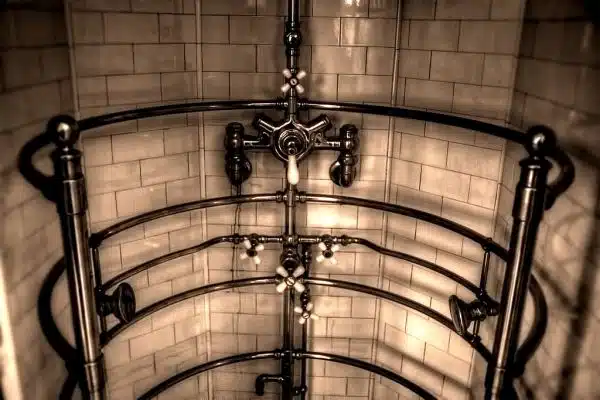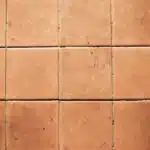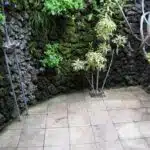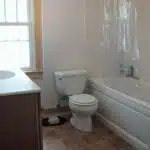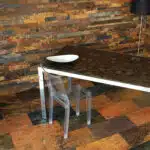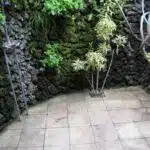As a bathroom remodeling specialist, I understand the importance of creating a comfortable and functional space for homeowners. One area that often requires attention is the shower stall. A dated or worn-out shower stall can detract from the overall aesthetic appeal of the bathroom and make it less enjoyable to use. However, with the right knowledge and tools, you can easily remodel your shower stall with tile to create a beautiful and long-lasting finish.
In this article, we will discuss how to remodel a shower stall with tile, step-by-step. We will cover everything from selecting the right type of tile to preparing the surface for installation. With our guidance, you will be able to transform your shower stall into a stunning feature of your bathroom that is both practical and stylish. So if you are ready to take on this exciting project, let’s get started!
Assessing The Condition Of Your Shower Stall
As a bathroom remodeling specialist, it never ceases to amaze me how often homeowners neglect their shower stalls. It’s as if they believe the water pouring out of their showerheads is made of fairy dust instead of hard minerals that corrode grout and tiles over time. But fear not, dear reader, because assessing the condition of your shower stall is the first step towards a successful remodel.
Begin by inspecting all surfaces for any sign of damage. Look for loose or cracked tiles, missing or moldy grout, and any signs of water damage. Check the shower pan for cracks or leaks that can cause water to seep into your subfloor and create a breeding ground for mold and mildew.
Once you’ve assessed the condition of your shower stall, it’s time to repair any damage before moving on to tile selection. Replace any broken or missing tiles and re-grout where necessary. If your shower pan has cracks or leaks, consider replacing it entirely to prevent future moisture problems. Remember: a solid foundation is crucial to ensuring your new tile installation lasts for years to come.
Now that you’ve assessed the condition of your shower stall and repaired any damage, it’s time to choose the right type of tile for your project. Keep reading to learn about the different types of tile available and which one will work best for you!
Choosing The Right Type Of Tile For Your Project
When it comes to selecting the right type of tile for your shower stall remodel, there are a few factors to keep in mind. One of the first considerations is color options. Tiles come in a wide range of colors and patterns, from classic white to bold hues like navy blue or forest green. It’s important to choose a color that complements the overall design scheme of your bathroom while also creating a visually appealing shower space.
Another important factor when choosing tile is size. Larger tiles can make a small shower appear larger, while smaller tiles can create intricate patterns and designs. Consider the size of your shower stall and the layout you want to achieve before selecting your tile size. Keep in mind that larger tiles may require less grout, making them easier to clean and maintain over time.
Ultimately, the key to selecting the right type of tile for your shower stall remodel is finding a balance between aesthetics and practicality. Take into account factors like tile color options and size considerations, but also think about how well each option will hold up over time and how easy it will be to clean and maintain. In the next section, we’ll discuss how to measure your shower stall for accurate tile placement so you can get started on your project with confidence.
Measuring Your Shower Stall For Accurate Tile Placement
As we embark on the process of remodeling your shower stall with tile, it is important to measure the space accurately. Much like a chef measuring ingredients for a recipe or a tailor taking precise measurements for a suit, the success of your shower remodel hinges on accurate measurements. By doing so, you can maximize the space and design options available to you.
To begin, gather a tape measure and paper and pencil. Start by measuring the height of your shower stall from floor to ceiling. Then, measure the length of each wall individually, as well as the width of each wall. Take note of any irregularities in shape or size, such as angles or curves, as these will impact your tile placement.
Once you have all necessary measurements recorded, it’s time to get creative with design options. Consider using different sizes and shapes of tiles to create interest and depth within the shower. Vertical or horizontal patterns can also add visual interest. By accurately measuring your shower stall and considering design options, you can create a beautiful and functional space that maximizes every inch available.
Transition: Now that you have measured your shower stall and considered design options, it’s time to gather the necessary tools and materials for tiling.
Gathering Necessary Tools And Materials
To begin your shower stall remodel, it’s essential to gather all the necessary tools and materials. This will ensure a smooth and efficient process that saves you time and effort in the long run. Before starting, make sure you have all the supplies on hand to avoid interruptions or delays that could hinder your progress.
Firstly, choosing the right tile for your shower is crucial. You want to select a material that is both durable and visually appealing. Porcelain, ceramic, glass, and stone are popular options for bathroom tiles because of their durability and water-resistant properties. Consider the color and texture of your chosen tile carefully as they will determine the aesthetic of your bathroom.
Gathering supplies involves more than just picking out tile; it also includes purchasing additional items like grout, thinset mortar, spacers, cement boards, waterproofing membranes, and tools such as a trowel and tile saw. Creating a detailed list of everything you need before starting can help you keep track of what you have already purchased versus what still needs to be acquired. With all these materials on hand, you’ll be well-prepared to tackle the next step: removing old tile and preparing the surface for new tiles.
Next up is removing old tile and preparing the surface for new tiles. This involves removing any existing tiles from the shower walls or floor using chisels or hammers while being careful not to damage any plumbing fixtures or pipes behind them. Once removed, inspect the surface for any cracks or damage that needs repairing before installing new tiles. Preparing surfaces may also include applying waterproofing membranes or cement board to protect against water damage over time. By completing these essential steps in preparation for laying new tile in your shower stall remodel project ensures a smooth process ahead with no hiccups along the way.
Removing Old Tile And Preparing The Surface
Removing old tile can be a daunting task, but with the right tools, it can be done efficiently. The best tools to use for removing old tile include a hammer, chisel, and scraper. Begin by breaking up the tiles with the hammer and chisel, then use the scraper to remove any remaining adhesive or grout. It is crucial to wear protective gear like gloves, goggles, and a respirator mask while working on this step.
To ensure success when removing old tile, it is essential to avoid common mistakes made during this process. One of these mistakes includes not using enough force when breaking up the tiles, which can result in prolonged removal time. Another mistake is not taking enough care when using sharp tools like chisels and scrapers, as they can cause injury if mishandled. Additionally, it’s essential to check for any underlying damage or leaks before proceeding with further renovations.
After removing old tiles and thoroughly cleaning the surface area, preparation of the surface begins by leveling any uneven spots on the wall or floor. Once leveled, you will need to clean thoroughly again before priming with a waterproof primer that seals off pores in the existing substrate. This critical step helps ensure that moisture does not penetrate the surface of your new tiling job and cause further damage over time. Sealing is another important aspect of preparing surfaces for tiling by creating an impenetrable barrier against water damage.
Preparing surfaces for new tile installation requires careful attention to detail and patience. It may take several hours or even days to complete this step effectively depending on the extent of damage caused by previous installations. However, proper preparation ensures that your new shower stall will remain structurally sound while providing years of service without any issues related to water penetration into surrounding walls or floors – preventing costly repairs down the line!
Applying Waterproofing Membrane To Prevent Water Damage
After removing the old tiles and preparing the surface, it’s time to move on to applying waterproofing techniques. This step is crucial in ensuring that your shower stall remains free from water damage for years to come. Waterproofing membranes are necessary as they prevent moisture from seeping into the walls and causing mold and mildew growth.
One of the most common mistakes people make while waterproofing their shower stalls is not paying attention to detail. It’s essential to ensure that every nook and cranny of the stall is covered with a waterproofing membrane. Even small gaps can lead to water damage over time, so it’s best to be thorough.
Another mistake people make is not using enough waterproofing material. Most manufacturers provide guidelines on how much material should be used per square foot of space, depending on factors such as substrate type and thickness. It’s crucial to follow these instructions closely to avoid any potential leaks or damage.
- Here are five tips for applying a waterproofing membrane effectively:
- Start by priming the surface before application.
- Use a high-quality brush or roller for even coverage.
- Ensure that all seams and corners are properly sealed with extra attention.
- Allow sufficient drying time between coats as per manufacturer’s recommendations.
- Double-check every inch of the surface before proceeding further.
With proper preparation and attention to detail, applying a waterproofing membrane can be relatively straightforward. Once you’re confident that your shower stall is fully protected, you can move on to laying the first row of tiles. But before we get into that, let’s touch upon some common mistakes people make during this next phase of remodeling.
Laying The First Row Of Tiles
As we move forward with the shower stall remodel, the first step is to plan out the layout of our tiles. This is essential to ensure that the tiles are laid out uniformly and in a way that compliments the design. We recommend starting at the center of the shower floor and working outward towards the edges.
Once we have determined our layout, it’s important to consider tile spacing techniques. The distance between each tile will determine how your finished product looks, so take care in deciding what spacing will work best for your design. We suggest using spacers to ensure a consistent gap between each tile.
When it comes time to lay down your first row of tiles, start by spreading thin-set adhesive on a small section of the shower floor using a notched trowel. Carefully lay down your tiles in a straight line and press them firmly into place. Continue this process until you have completed your first row of tiles. With these initial steps done correctly, we can now move onto cutting tiles to fit around edges and corners without any issues.
Cutting Tiles To Fit Around Edges And Corners
Cutting tiles for edges requires measuring the space, marking the tile to be cut, cutting the tile along the marked lines, and testing the fit before adhering it to the wall. Cutting tiles for corners requires first marking the corner, then cutting the tile along the marked lines, then measuring the angle to ensure it is a perfect fit. Lastly, the tile must be tested to ensure it fits the corner before adhering it to the wall.
Cutting Tiles For Edges
When cutting tiles for edges, it is important to use the right technique. One of the most commonly used tile cutting techniques is the wet saw method. A wet saw is a power tool that uses water to lubricate and cool down the blade, allowing it to cut through tiles smoothly and without cracking them. It is recommended that you use a wet saw when cutting ceramic or porcelain tiles as they are harder than other types of tiles.
When using a wet saw, ensure that you have the correct equipment. Make sure that you have the right blade for your tile type and thickness, and that your blade is sharp. Dull blades can cause chipping or cracking in your tiles. Additionally, make sure that you wear protective gear such as goggles and gloves to prevent injury.
It is also worth noting that there are other tools available for cutting tiles such as score-and-snap cutters and angle grinders. However, these tools may not be suitable for all types of tile or cuts required for edges. It is always best to consult with a professional if you are unsure about which tool to use when cutting your tiles for edges.
Cutting Tiles For Corners
When it comes to cutting tiles for edges and corners, there are various cutting techniques that bathroom remodeling specialists use. However, it is essential to choose the right method that suits your tile type and thickness. One of the most challenging tasks is cutting tiles for corners since they require precise cuts to fit together perfectly. Common mistakes made when cutting tiles for corners include not measuring correctly or not using the correct tool.
To achieve a perfect cut on your corner tiles, you need to use a wet saw or angle grinder. Wet saws are considered the best option as they produce clean cuts without damaging the tile’s surface. When using a wet saw, ensure that you use the appropriate blade for your tile type and thickness. Additionally, make sure that you have all protective gear in place before commencing work.
Another technique used when cutting tiles for corners is using an angle grinder. This method is suitable when dealing with hard stone tiles such as granite or marble. When using an angle grinder, ensure that you have the correct blade and diamond grinding wheel attached to avoid damaging your tile’s surface. Remember always to keep safety in mind when handling any power tools during bathroom remodeling projects.
Applying Adhesive And Setting Tiles In Place
After cutting the tiles to fit around edges and corners, it’s time to move on to the next step: tile selection. Choosing the right type of tile is crucial in shower stall remodeling. Porcelain and ceramic tiles are popular options because they are durable, water-resistant, and easy to clean. Natural stone tiles like marble or granite can add a luxurious touch but require more maintenance.
Once you’ve chosen your tiles, it’s important to consider grout color. Grout is the material used to fill in the spaces between tiles, and its color can impact the overall look of your shower stall. A contrasting grout color can create a striking effect, while matching grout color can create a seamless look. Keep in mind that lighter colored grout may need more frequent cleaning than darker colors.
When applying adhesive and setting tiles in place, make sure to leave space between each tile for grout lines. Once all the tiles have been set, it’s time to grout between them for a professional finish. Grouting involves applying a mixture of water, cement, and sand into the spaces between tiles with a rubber float tool. After allowing the grout to set for about 10-15 minutes, wipe away any excess with a damp sponge until the surface is smooth and clean. With these steps completed, your newly tiled shower stall will be ready for use!
Grouting Between Tiles For A Professional Finish
Just as tiles provide a beautiful and durable surface in shower stalls, the grout between them also plays an important role. Grouting between tiles is not just about filling gaps, but also about creating a seamless and professional-looking finish. To achieve this, it is recommended to use colored grout that complements the tile color or contrasts it for a bold look. This creates an aesthetically pleasing effect that elevates the overall design of the shower stall.
Once the grouting is completed, it’s vital to clean it properly to remove any excess grout residue before it dries. A common mistake when cleaning grout is using too much water, which can weaken its structure and cause cracks over time. Instead, use a damp sponge or cloth to gently wipe away any excess grout from the surface of the tiles. Afterward, use a dry cloth to buff out any remaining haze. This will ensure that the finished product looks polished and professional.
Grout cleaning techniques are essential for maintaining your shower stall’s appearance and longevity. Regular cleaning with mild soap and water can help keep your shower looking new for longer periods. If you notice discoloration or stubborn stains on your grout, consider using specialized cleaning products designed specifically for removing tough stains from grout surfaces. With proper care and maintenance, your newly remodeled shower stall with tiled walls will be a long-lasting investment in both style and functionality.
To prevent moisture damage and stains from developing on your newly created tile work in your shower stall, you must take steps to seal the grout after it has fully dried. In our next section, we will discuss how sealing grout can protect against moisture buildup while enhancing both durability and cleanliness of your bathroom space.
Sealing Grout To Prevent Stains And Moisture Damage
After grouting your shower tiles, it’s important to clean off any excess grout that may have gotten on the tiles during the process. Use a damp sponge in circular motions to gently remove any excess grout. Be sure not to use too much water which can weaken the grout lines and cause them to crack over time.
Once your grout is dry, it’s important to properly maintain it to prevent stains and moisture damage. Regular cleaning with warm water and a mild detergent will help keep your grout looking its best. Avoid using harsh chemicals or abrasive cleaners as they can damage the grout and cause discoloration.
In addition to regular cleaning, consider applying a sealer to your grout lines every six months to protect against moisture damage and staining. Choose a high-quality sealer that is specifically formulated for use on tile grout. Follow the manufacturer’s instructions carefully when applying the sealer for best results. By following these maintenance tips, you can ensure that your shower stall with tile remains beautiful and functional for years to come.
When it comes time to installing shower fixtures and accessories, there are several factors you should consider before making any decisions. First, think about the overall style of your bathroom and choose fixtures that complement this look. Next, consider functionality – do you need a handheld showerhead or multiple spray options? Finally, think about durability – choose fixtures made from high-quality materials that will withstand daily use without showing signs of wear and tear. With these considerations in mind, you can confidently choose the perfect shower fixtures and accessories for your newly remodeled space.
Installing Shower Fixtures And Accessories
When it comes to remodeling a shower stall, installing the fixtures and accessories can make all the difference in creating a functional and stylish space. Choosing the right fixtures is essential to ensure optimal water flow and temperature control. Consider installing a showerhead with multiple settings for a customizable experience, as well as a thermostatic valve to maintain consistent water temperature.
Accessorizing the space is also important for both functionality and aesthetics. Install shelves or niches to hold shampoo, soap, and other toiletries, as well as a towel bar or hook for easy access to towels. Don’t forget about safety features such as grab bars or non-slip flooring for added security in the shower.
Overall, with careful consideration of fixture selection and accessorizing, your newly tiled shower stall can become a luxurious retreat within your home. In the next section, we will discuss how to properly clean and maintain your newly remodeled space to ensure its longevity and durability.
Cleaning And Maintaining Your Newly Tiled Shower Stall
Now that you have successfully installed your shower fixtures and accessories, it is time to move on to the next phase of remodeling your shower stall: tiling. Tiling a shower stall can be a challenging task, but with patience and attention to detail, you can achieve great results. In this section, we will discuss how to clean and maintain your newly tiled shower stall.
Maintaining grout is an essential part of keeping your tiled shower stall looking its best. Over time, grout between tiles can become discolored or cracked. To prevent this from happening, it is important to apply a sealant to the grout after installation. This will help protect the grout from moisture and prevent mildew growth. Regular cleaning with a mild soap solution and soft-bristled brush will also help keep the grout in good condition.
Preventing mildew from growing in your newly tiled shower stall is crucial for maintaining cleanliness and preventing health problems. Mildew thrives in warm, moist environments, making showers an ideal breeding ground for spores. To prevent mildew growth, ensure that your bathroom has proper ventilation by using an exhaust fan or opening windows during and after showers. You should also wipe down walls and floors after use with a squeegee or towel to remove excess moisture.
Numeric list of 4 items:
- Use a sealant on grout after installation
- Clean grout regularly with mild soap solution
- Ensure proper ventilation in bathroom
- Wipe down walls and floors after use with squeegee or towel
In order to troubleshoot common problems during the remodeling process, it is important to stay vigilant throughout each step of the process. One common issue that arises during tiling is uneven tile placement or gaps between tiles. This can be caused by incorrect measurements or improper adhesive application. To fix this problem, carefully remove any loose tiles and reapply adhesive before replacing them.
Another common issue is water damage to walls or floors. This can be caused by leaks in plumbing fixtures or improper waterproofing during installation. If you notice any signs of water damage, such as mold or discoloration, it is important to address the issue immediately. Repair any leaks and consider installing a waterproof membrane to prevent future damage.
By following these tips and staying proactive throughout the remodeling process, you can ensure that your newly tiled shower stall remains beautiful and functional for years to come.
Troubleshooting Common Problems During The Remodeling Process
As the old saying goes, “measure twice, cut once.” This is especially true when it comes to remodeling a shower stall with tile. Common mistakes during the process can lead to costly repairs and even the need for a complete redo. One of the most common mistakes is not properly waterproofing the shower area before installing tile. This can lead to water damage and mold growth over time. DIY solutions for this problem include using a waterproofing membrane or coating on all surfaces that will come into contact with water.
Another common mistake is not properly preparing the surface before tiling. This can result in tiles that are uneven or don’t adhere properly, leading to a less-than-professional look. Budget friendly alternatives for this issue include using a leveling compound or sanding down any high spots on the surface. It’s also important to choose the right adhesive for your specific tile material and surface.
It’s important to remember that remodeling a shower stall with tile can be a complex process, but it doesn’t have to break the bank. By avoiding these common mistakes and utilizing DIY solutions and budget-friendly alternatives, you can achieve professional-looking results without spending a fortune. In the next section, we’ll provide tips for a successful and stress-free shower stall remodel that will leave you feeling confident in your DIY skills and proud of your updated bathroom space.
Tips For A Successful And Stress-Free Shower Stall Remodel
After troubleshooting common problems during the remodeling process, it’s time to move on to the exciting part – designing and remodeling your shower stall with tiles! This is a great opportunity to add some personality and style to your bathroom while also increasing its value. In this section, we will provide you with tips for a successful and stress-free shower stall remodel.
Firstly, before you start any work, it’s important to establish a budget. Setting a budget will help you stay on track and avoid overspending. When planning your budget, consider the cost of materials, labor, and any unexpected expenses that may arise. It’s also important to factor in an extra 10-15% of your total budget for unforeseen costs.
Next, when it comes to designing your shower stall with tile, there are endless possibilities for inspiration. From classic subway tiles to unique mosaic patterns, the options are vast. Consider the overall aesthetic of your bathroom when choosing your tile design and color scheme. If you’re unsure where to start or need some design inspiration, do some research online or consult with a professional bathroom remodeler.
Here are some additional budgeting tips and design inspiration:
- Choose larger tiles as they tend to be more affordable than smaller ones.
- Go for neutral colors if you plan on selling your home in the future as they have mass appeal.
- Consider adding accent tiles for a pop of color or texture.
- Experiment with different layouts such as diagonal or herringbone patterns.
- Mix and match tile designs for a unique look.
In summary, remodeling your shower stall with tile can be a fun and rewarding project. Remember to establish a budget beforehand and take inspiration from various designs before settling on one that suits your personal style. With these tips in mind, you’ll be well on your way towards achieving the bathroom of your dreams!
Conclusion
When considering a shower stall remodel, it is important to assess the condition of your current space and choose the appropriate type of tile for your project. Measuring accurately and gathering necessary tools and materials are also crucial steps in this process. Removing old tile and preparing the surface can be a challenging task, but with the right techniques, it can be done efficiently.
Once the surface is prepared, installing shower fixtures and accessories can add to the overall aesthetic appeal of your newly tiled shower stall. Regular cleaning and maintenance will ensure that your investment lasts for years to come. Troubleshooting common problems during the remodeling process is important to avoid any unnecessary complications.
As a bathroom remodeling specialist, I recommend taking time to plan out every step of this process and seeking professional assistance if needed. With proper preparation and attention to detail, your new tiled shower stall will provide a luxurious experience for you and your guests. Embrace this opportunity to elevate your bathroom’s style and function with a beautifully remodeled shower stall.
Image Credits
- “Shower Stall for HR Giger” by Glen Bledsoe (featured)

